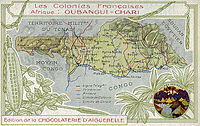
Back Centralafrikanske krig Danish Primera guerra civil centroafricana Spanish Première guerre civile centrafricaine French Közép-afrikai háború Hungarian Քաղաքացիական պատերազմ Կենտրոնաաֆրիկյան Հանրապետությունում (2004-2007) Armenian Prima guerra civile nella Repubblica Centrafricana Italian Den sentralafrikanske krig NB Wojna domowa w Republice Środkowoafrykańskiej Polish Guerra Civil na República Centro-Africana (2004–2007) Portuguese Гражданская война в ЦАР (2004—2007) Russian
| Central African Republic Bush War | |||||||
|---|---|---|---|---|---|---|---|
 The town of Birao in northern CAR which was largely burnt down during the fighting in 2007 | |||||||
| |||||||
| Belligerents | |||||||
|
Rebels: ...and others
|
| ||||||
| Commanders and leaders | |||||||
|
Michel Djotodia (UFDR,[1] GAPLC[2]) Abakar Sabon (MLCJ)[2] Justin Hassane (FDC)[2] |
| ||||||
| Strength | |||||||
| 150+[citation needed] | 4,500+[citation needed] | ||||||
| Casualties and losses | |||||||
|
Civilian casualties: Hundreds killed, 212,000 displaced[4] | |||||||
|
|---|
 |


The Central African Republic Bush War[5] was a civil war in the Central African Republic which lasted from 2004 to 2007 between Union of Democratic Forces for Unity (UFDR) rebels and government forces. The rebellion began after François Bozizé seized the nation's presidency in 2003. Actual fighting began in 2004.[6] Around 10,000 people were displaced because of the civil unrest.[1]
The rebellion consisted of multiple rebel groups, several of which were of very small size and founded only towards the end of the conflict. Apart from the UFDR, the conflict included the People's Army for the Restoration of Democracy (CAR) (APRD), Groupe d'action patriotique pour la liberation de Centrafrique (GAPLC), the Movement of Central African Liberators for Justice (MLCJ), the Front démocratique Centrafricain (FDC), and Union of Republican Forces (UFR).[2]
A number of peace agreements have been signed to resolve the conflict between 2007 and 2012. The most important agreement, the Global Peace Accord (signed in Libreville, Gabon, on 21 June 2008), was first signed by the ARPD, UFDR, and FDPC groups. The agreement granted amnesty for any acts perpetrated against the state prior to the agreement, and called for a disarmament and demobilization process to integrate former rebels into society and the regular CAR armed forces.
Other rebel groups signed on to the agreement later, or signed similar agreements with the government (e.g. UFR on 15 December 2008). The only major group not to sign an agreement at the time was the CPJP, which continued its activities and signed a peace agreement with the government on 25 August 2012.[7]
- ^ a b IRIN (13 November 2006). "CAR: Concern as civilians flee, government denies rebel capture of third town". IRINnews. Retrieved 11 March 2013.
- ^ a b c d IRIN (2 November 2006). "CAR: Rebels call for dialogue after capturing key town". IRINnews. Bangui. Archived from the original on 28 August 2010. Retrieved 9 March 2013.
- ^ Lamba, Sebastien. "Les obsèques de Jean-Célestin Dogo". acap.cf. Agence Centrafricane de Presse. Archived from the original on 11 November 2022. Retrieved 22 February 2023.
- ^ Human Rights Watch (15 September 2007). State of Anarchy: Rebellion and Abuses against Civilians. Human Rights Watch. Archived from the original on 5 March 2016. Retrieved 9 March 2013.
- ^ Hancock, Stephanie (8 August 2007). "Bush war leaves Central African villages deserted". Reuters. Bodouli, Central African Republic. Archived from the original on 6 March 2016. Retrieved 30 June 2017.
- ^ BBC (23 November 2004). "Raid on CAR town 'leaves 20 dead'". BBC. Archived from the original on 11 January 2013. Retrieved 9 March 2013.
- ^ "CENTRAL AFRICAN REPUBLIC: Peace Agreement". Africa Research Bulletin: Political, Social and Cultural Series. 50 (1): 19566A – 19567B. 27 February 2013. doi:10.1111/j.1467-825X.2013.04903.x. Archived from the original on 24 June 2022. Retrieved 24 June 2022.